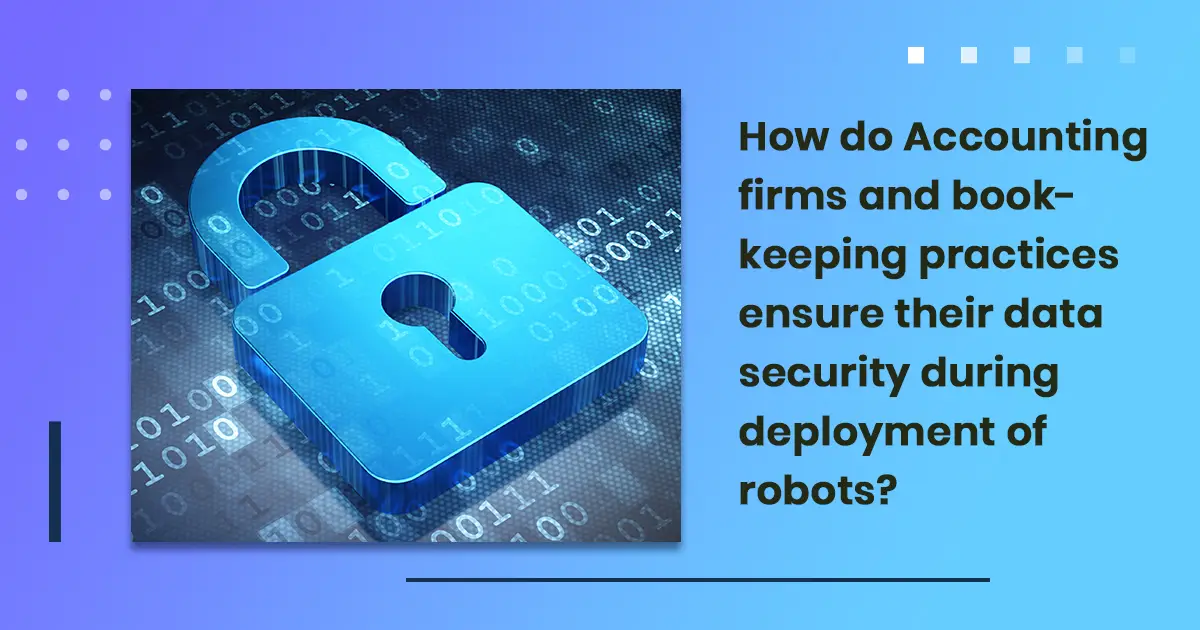
How do Accounting firms and bookkeeping practices ensure their data security during deployment of robots?
Dec 29, 2023
The integrated business world of today has found their ‘New poster boy’ - (Robots). It is engineered for easy deployment within organizations in order to save time and manual effort within the office environment. It is applied across all processes where there is scope for uniformity, repetitiveness and structured information. Therefore, these robots handle confidential information related to customers, finance and accounting.
When there is sensitive information, there arises a need for safeguarding of the data. Organizations globally, spend their resources for safeguarding and protecting the data from unauthorized access. The two main risks arise from data leakage and fraud.
When enterprises or firms do not have proper security measures in place, they are under constant threat from sophisticated cyber-attacks and internal intruders. Internal employees could also be a threat to expose data, knowingly or unknowingly.
Companies have to spend a sizable portion of their revenues in cybersecurity. Inorder for them to sustain in their business without any tarnished reputation that might arise due to cyber-attacks.
Worldwide spending on information security products and services exceeded $114 billion in 2018 according to Gartner, Inc. For 2019, they forecast the market to grow to $124 billion, and $170.4 billion in 2022.
Also Read: “What are the yardsticks to measure your ROI after Robotic Automation deployment?”
What are the measures that can be taken by firms in terms of security during deployment of software robots:
- Responsibility aligned for each robotic automation bot process
When firms start implementing Robotic automation (RPA) as a digital worker, they are enthusiastic to see quick results. Furthermore, the Robotic automation (RPA) development and deployment team wants to complete their tasks to meet their deadlines. In this gambit, the first casualty might be security. We come across instances where robot log-in and password and an employee login and password are the same. It is because of errors like these we cannot distinguish mistakes, cyber attacks or fraudulent actions if it was done by humans or robots. Therefore it is imperative that each robot is assigned with their own login id and password for traceability. - Distinct credentials assigned for each robotic automation bot process
It is advisable to provide Robotic automation (RPA) bot and process an unique set of credentials. Further, a time frame routine for changing the passwords should be implemented. There should be a distinct format or template of credentials handled between the employees and Robotic automation (RPA) bot. With this identity separation, it simplifies the tracking of who is responsible in case of issues. - Accessibility aligned for each robotics bot process
For security reasons, it is necessary to limit the Robotic automation (RPA) access to each bot strictly to conduct only their assigned task. Eg, If they are given access only for copying details from invoices etc, it will not be given access to other tasks like editing etc. It is necessary to have these task separation when programming. - Monitoring aligned for each robotic bot process
If segregation of duties is unavoidable, then it becomes necessary to identify the entire automation process if there are loopholes. So, in places where they are vulnerable, a review has to be done to prevent any mishaps. As a counter check, certain transactions completed by Robotic automation (RPA), when it crosses threshold limits, triggers another robot to monitor, before the output is validated. - Safeguarding logs of each Robotic automation (RPA) bot process
When a bot malfunctions, the investigative team will need to review the logs to understand where there was a security lapse. Firms usually have a separate system for storing the logs in a secure location. It becomes essential to safeguard such logs for future investigation or reference. - Review the scripts of each Robotic automation (RPA) bot process:
It is advisable to intermittently review and test Robotic automation (RPA) bots program/workflow/scripts in order to find out any issues in the overall execution. When the program/scripts are changed, the process needs to be reviewed and retested to find out issues. - Free version of robotic tools:
As a precautionary measure it is best not to use free versions of Robotic automation (RPA) tools on confidential documents or data. Free versions or trial versions are only for a limited period of time and therefore, it is vulnerable for attack and does not provide full security features.
Also Read: “Characteristics of top RPA automation implementation companies”
If you are an accounting firm interested in deploying robotic process automation with all the necessary security of your confidential data – we can get it done for you the right way. We have extensive experience in deploying secure accounting robotic solutions suitable for your accounting practice. Contact us to talk to accounting automation experts and book your free demo.
Schedule Your Free Demo
With our accounting automation experts
Find out how other practices have benefited using Integra Balance AI bookkeeping automation. 87% of practices who viewed AI bots in action have instantly discovered the advantages of using them at their firm.
Global Offices
US (Head Quarters)
Integra Global Solutions Corp
7500 Brooktree Road, Suite 100
Wexford (Pittsburgh)
PA 15090
+1 412 267 1529
Philippines
Integra Global Solutions Corp
Ayala Cebu Tower,
Cebu Business park, Cebu 6000
+1 412 267 1529
Europe
Integra Global Solutions UK Ltd
College House
17 King Edwards Road
Ruislip, London, UK, HA4 7AE
+44 (0)20 7993 2949
Canada
Integra Global Solutions Corp
32 Blencathra Hill, Unit 100, Markham
Ontario
+1 412 267 1529
India
Integra Global Solutions Corp
First floor, Kanapathy Towers,
Opp.BSNL exchange, Ganapathy,
Coimbatore – 641 006, India
+91 (0422) 437 9555
Australia
Integra Global Solutions Corp
+61 02 8005 1836
